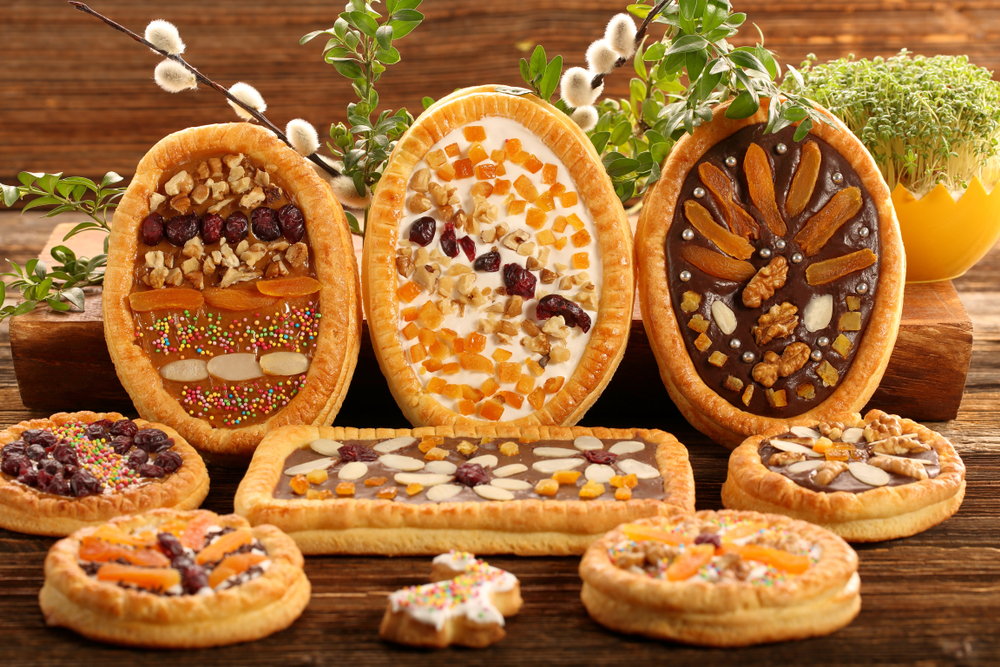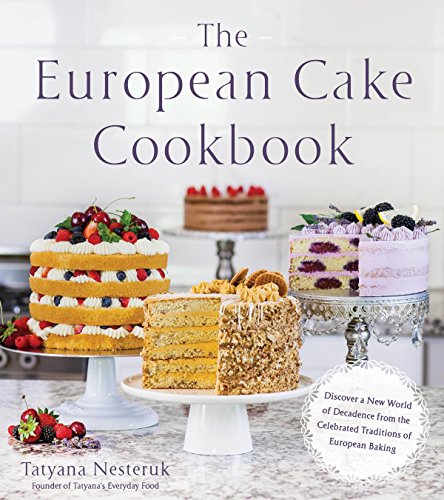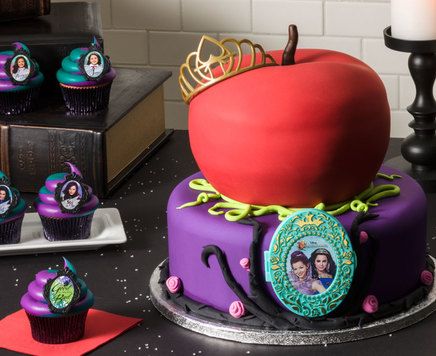Whether you’re planning a trip abroad, or you’re merely trying to find some new desserts to spice up your dinners at home, look at the vast and delicious selection of pastries from Europe. We’ve compiled a list of baked delicacies that everyone should taste at least once.
Some are classic recipes from medieval times. Others are from the 20th century. But all are uniquely representative of their countries of origin. Here are 12 types of European pastries you must add to your bucket list.
Polish Mazurek
Mazurek is a traditional Polish cake with many variations. You’ll typically see it around Easter as a way to celebrate the end of Lent. It consists of flat pastry crusts, sometimes with jam or sponge cake or chocolate in between. Chocolate icing or jelly top it with along with decorated with frosting or candied fruits.
The origin of the name of the Mazurek cake is debated. Some believe it was named after the Mazur tribe. Others theorize that it is the name of a traditional Polish folk dance called mazurka. Though it’s quintessentially Polish, the recipe most likely originated in Turkey and came to Poland in the early 17th century.
In Poland, Mazurek is almost always homemade and eaten for special occasions. You’ll recognize a Mazurek by its decoration—typically kitschy and with Easter symbolism or child-friendly cartoons.
Hungarian Dobos Torte
Dobos is a Hungarian cake with five layers of sponge cake alternating with chocolate buttercream and topped with caramel. A Hungarian baker named Jozsef Dobos invented it while trying to design a cake that would last a long time without refrigeration.
The Dobos torte was among the first known uses of buttercream which Dobos invented too. He introduced his creation at the National General Exhibition of Budapest in 1885 where King Franz Joseph I and Queen Elisabeth were the first to taste it. Dobos did not share his recipe until his retirement in 1906.
Though refrigeration techniques have vastly improved since the late 19th century, Dobos tortes are still a favorite dessert in Hungary. You can find a variety of recipes for them online and on the Food Network.
Croatian Rab Cake
The Rab Cake (or Rapska Torta in Croatian) is a thin cake originating from the island of Rab just off the northern coast of Croatia. Th ingredients include almonds and Maraschino liqueur. It’s traditionally baked in a spiral shape.
The legend of the origin of the Rab Cake is that it was first served to Pope Alexander III in 1177 when he consecrated the Assumption Cathedral in the city of Rab. Thus, you’ll often see the traditional Rab Cake at religious events such as weddings and baptisms.
Despite its religious associations, Rab Cake became a specialty among the wealthy inhabitants of Rab Island during the time of Venetian rule in the 18th century.
Czech Bublanina
Bublanina, or “bubble cake,” is a light, sweet Czech bread made with whatever fresh fruit is in season, Cherries, plums and berries are common ingredients. It comes from the mountains of Czech and Slovakia as a way to use up excess fruit gathered from the native trees in spring, summer, and early fall.
Because of how light it is, Bublanina is traditionally served as a breakfast pastry or as a summer dessert. The name likely comes from the way the batter bubbles up over the fruit on the surface. Bublanina is quick and easy to make. Its sweetness makes it popular with Czech children.
German Franzbrötchen
A Franzbrötchen is a sweet German pastry similar to a croissant filled with butter and cinnamon and sometimes raisins or chocolate. Traditionally, Franzbrötchen is first baked and then fried in animal fat to give them distinctive crispiness. They’re commonly found in Hamburg, in northern Germany, where they are eaten as breakfast or as a snack with coffee.
The name, Franzbrötchen, likely comes from Französisch, which is the German word for France. Legend has it that the French croissant was introduced in Hamburg during Napoleon’s occupation in the early 1800s. The Germans loved them so much that they created their own version after they regained control.
French Madeleines
France is a country that has become synonymous with fantastic food, especially desserts. It was hard to choose just one pastry for this list, but ultimately the delectable shell-shaped Madeleine beat out all the rest. It’s a light, buttery, cake-like cookie baked in a special mold to give it its distinctive shell shape.
The Madeleine’s exact origin is unknown. It became popular by French King Louis XV. The legend goes that he named them after his father-in-law’s beloved cook, Madeleine Paulmier, who may have invented them. Louis XV’s wife Marie introduced Madeleines to the court at Versailles, where they became a big hit.
Nowadays, Madeleines are enjoying some popularity in the United States, but they’re still more commonly found in European bakeries.
Greek Loukoumades
The Greek Loukoumades are little deep-fried dough balls that are covered with honey and sprinkled with cinnamon and powdered sugar. They are traditionally eaten by Greek Jews as a Hanukah treat, but their origin and usage go beyond religious tradition.
The origin of Loukoumades is hotly contested. The ancient texts contain some mention of similar desserts, though none of them bore the same name. Some believe a version Loukoumades were served to victors at the original Olympics.
Wherever they originally came from, Greek Loukoumades are easy to prepare and can be eaten as a breakfast, snack, or dessert.
Russian Ptichye Moloko
Ptichye Moloko is the name for both a cake and a candy. The candy version originated in Poland in 1936, then was introduced in Russia during the Soviet Era. After 1978, Vladimir Guralnik invented the cake version in his restaurant, Praga, in Moscow. Ptichye Moloko is a spongy cake layered with light, airy soufflé and topped with chocolate.
In Russian, the name Ptichye Moloko directly translates to “bird’s milk.” Obviously, neither the cake nor the candy contains actual milk from a bird. Instead, bird’s milk is an ancient European idiom for something that is wholly unattainable like milk from a bird.
You’ll see Ptichye Moloko in Russian supermarkets and restaurants. It is one of the most popular everyday desserts.
Finnish Runeberg Torte
The Runeberg Torte (or Runebergintorttu, in Finnish) is a small, dense cake flavored with rum and almonds, and topped with raspberry jam inside a circle of sugar icing. It is named for Johan Ludvig Runeberg, Finland’s national poet. His wife may have even invented it in the 1850s.
Legend has it that Runeberg ate these little cakes for breakfast every morning. Nowadays, Runeberg Tortes are consumed on Runeberg’s birthday, February 5th, though they’re widely available in stores from early January through the end of February.
Runeberg Tortes haven’t found much popularity outside of Finland. However English-language recipes can be found online if you want to experience this celebrated pastry without making the trip across the pond.
Ukrainian Pampushka
A Pampushka is a small bun or donut from Ukraine that can be either savory or sweet. The base is yeast dough. The sweet version traditionally includes a filling of rose preserve and tossed with sugar. Though the origin of the Pampushka is unknown, the most famous theory is that t German colonists brought them to Ukraine in the 18th century.
The word Pampushka is the diminutive form of pampukh which roughly translates as “pancake.” Despite the implications of the name, the Pampushka is typically baked in an oven, rather than fried in a pan. In modern Ukraine, there is a yearly Pampushka festival during the Orthodox Christmas season.
Austrian Linzer Torte
The Linzer Torte is thought to be the world’s first real pastry. It originated in Austria in the 17th century, most likely in Vienna, though it’s named for the city of Linz.
The Linzer Torte is a short pastry with a crumbly dough crust that is flavored with cinnamon and ground nuts and filled with jam made from red currants, apricots, raspberries, or plums. You’ll recognize a Linzer Torte by the distinctive lattice of thin dough strips across the top.
There are numerous legends about the invention of the Linzer Torte. The oldest known recipe is from 1653 from a codex in the archives at Admont Abbey, a Benedictine monastery in Austria. It was brought to Milwaukee in the United States in the 1850s, where it quickly gained popularity. The Linzer torte is a holiday favorite, eaten at Christmas in countries all over Europe.
Swedish Prinsesstarta
The Prinsesstarta, or “Princess Cake,” is a traditional Swedish torte made up of layers of sponge cake and pastry cream, topped with a dome of whipped cream and then covered in a layer of marzipan. The original Prinsesstarta was made with green marzipan with a delicate pink marzipan rose on top.
The name Princess Cake comes from the fact that it was the favorite dessert of the three daughters of Swedish Prince Carl, Duke of Västergötland, in the early 1900s.
The first published recipe for Prinsesstarta was in 1948 in a cookbook published by Jenny Åkerström, who was a teacher of the Swedish princesses. Different variations have arisen over the years, such as the Prince Cake, which is covered in yellow marzipan, and the Opera Cake, covered in pink and red marzipan.
The Princess Cake has enjoyed recent popularity in the United States, where it is served at some Ikea furniture stores.
Last update on 2025-04-01 at 11:37 / Affiliate links / Images from Amazon Product Advertising API








